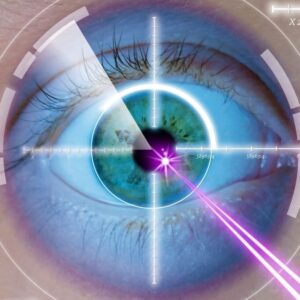Astigmatism is a common vision problem when the front surface of the eye (cornea) or the lens inside the eye is shaped irregularly, causing light to be distorted as it enters the eye. This distortion results in blurred or distorted vision, especially at a distance or near, and is often described as seeing multiple images or straight lines appearing wavy.
Astigmatism can be present on its own or in combination with other vision problems, such as nearsightedness or farsightedness, and can be corrected with eyeglasses, contact lenses, or refractive surgery.
What is an Astigmatism Test?
An astigmatism test is an eye exam that measures the degree and axis of astigmatism, which is a common vision problem caused by an irregularly shaped cornea or lens. The test is typically performed by an optometrist or ophthalmologist using a retinoscope, a phoropter, or a computerized instrument to shine light into the eye and determine how the light is bent as it enters the eye. The test helps diagnose astigmatism and determine the best corrective lens prescription to improve the patient’s vision.
Symptoms of Astigmatism?
Determining your symptoms can help you identify potential astigmatism and determine whether you should seek professional eye care. Some common symptoms of astigmatism include:
- Blurred vision: This can be a sign of astigmatism and cause difficulty seeing objects clearly at any distance.
- Eyestrain or headaches: Astigmatism can cause discomfort and strain when trying to focus, leading to frequent headaches or eyestrain.
- Double vision: In severe cases, astigmatism can cause double vision when looking at objects.
- Poor night vision: Astigmatism can also cause difficulty seeing at night and may cause halos or glare around lights.
- Squinting: Individuals with astigmatism may frequently squint to see objects more clearly.
It’s essential to remember that other vision conditions can also cause these symptoms and that a professional eye exam is necessary to determine a definitive diagnosis. If you suspect you have astigmatism, it’s best to schedule an appointment with an eye doctor for a comprehensive eye exam.
How Does an Online Astigmatism Test Work?
Online astigmatism tests are designed to provide a general idea of whether an individual may have astigmatism, a common vision problem caused by an irregularly shaped cornea or lens. These tests are typically performed on a computer and require the user to answer questions about their vision symptoms and perform tasks on the computer screen. They work by analyzing the user’s responses and using algorithms to simulate the experience of an eye exam.
However, it’s important to note that online astigmatism tests are not a substitute for a professional eye exam. They can only provide a general indication of whether someone may have astigmatism and the severity of the condition. An online test cannot provide a definitive diagnosis or a prescription for corrective lenses, which a qualified eye doctor can only do after a comprehensive eye exam.
An online astigmatism test is helpful for individuals who suspect they may have the condition. Still, it’s recommended that they schedule an appointment with an optometrist or ophthalmologist to get a proper diagnosis and appropriate treatment.
What Are the Benefits of Getting Tested Online?
Getting tested for astigmatism online can have several benefits, including:
- Convenience: Online tests can be taken from the comfort of your home and at any time convenient for you, eliminating the need to travel to a doctor’s office.
- Accessibility: Online tests can be a convenient option for individuals who live in rural areas or have limited access to eye care professionals.
- Affordability: Online tests are often free or low-cost, making them a more accessible option for individuals who may not have the financial resources to pay for a comprehensive eye exam.
- Initial screening: Online tests can serve as a primary screening tool for individuals who suspect they may have astigmatism, allowing them to determine whether they need to schedule a professional eye exam.
- Awareness: Online tests can raise awareness of astigmatism and encourage individuals to seek professional eye care if they suspect they have the condition.
If you suspect you have astigmatism, it’s best to schedule an appointment with an eye doctor for a comprehensive eye exam. However, online astigmatism tests should not replace a professional eye exam and cannot provide a definitive diagnosis or a prescription for corrective lenses. It’s essential to keep this in mind.
How Does Technology Make It Easier to Detect Astigmatism?
Technology has made it easier to detect astigmatism in several ways:
- Computerized instruments: Modern eye exams often use computerized instruments, such as autorefractors and wavefront analyzers, to quickly and accurately measure the degree and axis of astigmatism. These instruments are much more precise than traditional manual instruments and can provide a more accurate diagnosis of astigmatism.
- Improved imaging technology: Advancements in imaging technology, such as corneal topographers, allow eye care professionals to create detailed maps of the cornea, which can provide more information about the shape and contour of the eye and assist in the diagnosis of astigmatism.
- Telemedicine: Telemedicine platforms allow eye care professionals to perform virtual eye exams and diagnose astigmatism remotely, making it easier for individuals in rural areas or with limited access to eye care to receive a diagnosis.
- Automated screening: Automated screening systems use computer algorithms to analyze images of the eye and provide a preliminary screening for astigmatism, making it easier for individuals to determine whether they need to seek professional eye care.
Overall, technology has made it easier to detect astigmatism by providing faster, more accurate, and more accessible methods of diagnosis. However, it’s important to note that technology should not replace a professional eye exam and that individuals who suspect they have astigmatism should still seek the advice of a qualified eye doctor.
Online Astigmatism Test
The test requires you to take off your glasses and stand 3 feet away from the screen. Cover your left eye with your left hand and look intently at the image, then switch by covering your right eye with your right hand.

If certain lines appear greyer than others when you look at them, you may have a vision issue and need a comprehensive eye exam from an ophthalmologist.
This Online test does not have a medical value, and we remind you that only your eye doctor can give an exact exam.
How Accurate Are Online Astigmatism Tests?
The accuracy of online astigmatism tests can vary widely. While these tests can provide a general idea of the presence of astigmatism, they are not a substitute for a comprehensive eye exam performed by a licensed eye doctor.
Online astigmatism tests use algorithms and software to detect potential astigmatism based on questions and images. However, these tests do not consider individual factors such as age, overall health, and the presence of other vision conditions, which can all affect the accuracy of the results.
In addition, online astigmatism tests do not have access to the same sophisticated diagnostic equipment and technology as an eye doctor, which can limit their accuracy. For example, online tests may not detect subtle or early stages of astigmatism, or they may not accurately measure the axis or magnitude of astigmatism.
In short, online astigmatism tests should not be used as the sole means of diagnosing astigmatism. If you suspect you have astigmatism, it’s essential to schedule a comprehensive eye exam with a licensed eye doctor who can provide a definitive diagnosis and develop an appropriate treatment plan.
How Can Patients Check for Other Vision Conditions with Tests?
In addition to astigmatism, several other vision conditions can be checked for using various tests, including:
- Nearsightedness (myopia): This can be tested using a standard eye chart and measured with a phoropter, which allows the eye doctor to determine the correct prescription for corrective lenses.
- Farsightedness (hyperopia): This can be tested using a standard eye chart and a phoropter.
- Presbyopia: This condition occurs with age and makes it difficult to focus on close objects. It can be tested using a standard eye chart and a phoropter, as well as a test that involves reading a small print at different distances.
- Cataracts: Cataracts can be tested using a slit-lamp exam, which involves shining a light into the eye to inspect the lens and look for signs of cloudiness.
- Glaucoma: This condition can cause damage to the optic nerve and result in vision loss. It can be tested using a tonometry test, which measures the pressure inside the eye, and a visual field test, which assesses peripheral vision.
- Macular Degeneration: This condition affects the macula, the part of the retina responsible for central vision. It can be tested using an Amsler grid, a chart to assess the central visual field, and optical coherence tomography (OCT), which creates detailed retina images.
It’s important to remember that these tests are often performed during a comprehensive eye exam and that individuals who suspect they have a vision condition should seek the advice of a qualified eye doctor. A comprehensive eye exam can provide a definitive diagnosis and help determine the best course of treatment.
Conclusion
Astigmatism is a common vision condition that can cause blurred vision and other symptoms. Technology has made it easier to detect astigmatism through computerized instruments, improved imaging technology, telemedicine, and automated screening systems.
Determining your symptoms can help you identify potential astigmatism and determine whether you should seek professional eye care.
However, it’s essential to remember that technology should not replace a professional eye exam and that individuals who suspect they have astigmatism should still seek the advice of a qualified eye doctor.
A comprehensive eye exam can provide a definitive diagnosis and help determine the best course of treatment.






